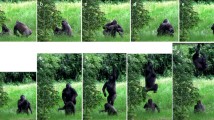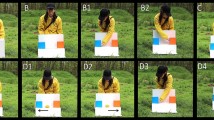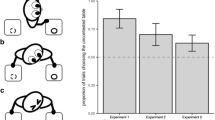Abstract
Many animal species use a variety of cognitive strategies to locate food resources. One strategy is to make inferences by exclusion, i.e., perceiving the absence of reward as a cue that another location should be investigated. The use of such advanced cognitive strategies may be more prominent in species that are known to frequently solve social challenges, and inferential reasoning has mainly been investigated in social species such as corvids, dogs, dolphins and non-human primates. In this paper, we investigate how far social intricacy may explain the disparity of reasoning performances observed in three cercopithecine species that differ in the density of their social network and the diversity of their social partners. We used standard reasoning tasks, testing the volume concept and inference by exclusion using visual and auditory modalities. We showed that Old World monkeys can infer the location of invisible food by exclusion. In addition, Tonkean macaques and olive baboons had greater performances in most tasks compared to rhesus macaques. These responses are consistent with the social complexity displayed by these three species. We suggest that the cognitive strategies required to navigate through a demanding social world are involved in the understanding of the physical domain.




Similar content being viewed by others
References
Amici F, Aureli F, Call J (2008) Fission-fusion dynamics, behavioral flexibility and inhibitory control in primates. Curr Biol 18:1415–1419
Amici F, Aureli F, Call J (2010) Monkeys and apes: are their cognitive skills really so different? Am J Phys Anthropol 143:188–197
Anderson JR (1986) Mirror-mediated finding of hidden food by monkeys (Macaca tonkeana and M. fascicularis). J Comp Psychol 100:237–242
Aureli F, Cords M, Van Schaik CP (2002) Conflict resolution following aggression in gregarious animals: a predictive framework. Anim Behav 64:325–343
Brown H, Prescott R (2006) Applied mixed models in medicine. Wiley, Amsterdam
Call J (2001) Object permanence in orangutans (Pongo pygmaeus), chimpanzees (Pan troglodytes), and children (Homo sapiens). J Comp Psychol 115:159–171
Call J (2004) Inferences about the location of food in the great apes (Pan panicus, Pan troglodytes, Gorilla gorilla, and Pongo pygmaeus). J Comp Psychol 118:232–241
Call J (2006) Inferences by exclusion in the great apes: the effect of age and species. Anim Cogn 9:393–403
Call J (2007) Apes know that hidden objects can affect the orientation of other objects. Cognition 105:1–25
Capitanio JP (1999) Personality dimensions in adult male rhesus macaques: prediction of behaviors across time and situation. Am J Primatol 47:299–320
Chaffin CL, Friedlen K, de Waal FBM (1995) Dominance style of japanese macaques compared with rhesus and stumptail macaques. Am J Primatol 35:103–116
Cheney DM, Seyfarth RM (1990) How monkeys see the world: inside the mind of another species. Chicago University Press, Chicago
Cheney DM, Seyfarth RM (1999) Recognition of other individuals’social relationships by female baboons. Anim Behav 58:67–75
Cunningham E, Janson C (2007) A socioecological perspective on primate cognition, past and present. Anim Cogn 10:273–281. doi:10.1007/s10071-007-0078-3
de Blois ST, Novak MA (1994) Object permanence in rhesus monkeys (Macaca mulatta). J Comp Psychol 108:318–327
Demaria C, Thierry B (2001) A comparative study of reconciliation in rhesus and Tonkean macaques. Behaviour 138:397–410
Drapier M, Chauvin C, Thierry B (2002) Tonkean macaques (Macaca tonkeana) find food sources from cues conveyed by group-mates. Anim Cogn 5:159–165
Ducoing AM, Thierry B (2003) Withholding information in semi free-ranging Tonkean macaques (Macaca tonkeana). J Comp Psychol 117:67–75
Ducoing AM, Thierry B (2005) Tool use learning in Tonkean macaques (Macaca tonkeana). Anim Cogn 8:103–113
Dunbar RIM (1988) Primate social systems. Croom Helm, London, Sydney
Fooden J (1982) Ecogeographic segregation of macaque species. Primates 23:574–579
Gouzoules S, Gouzoules H, Marler P (1984) Rhesus monkeys (Macaca mulatta) screams: representational Signalling in the Recruitment of Agonistic Aid. Anim Behav 32:182–193
Harlow HF, Mears C (1979) The human model: primate perspectives. Winston VH, Washington, New York
Hill A, Collier-Baker E, Suddendorf T (2011) Inferential reasoning by exclusion in great apes, lesser apes, and spider monkeys. J Comp Psychol 125:91–103
Hinde RA (1983) Primate social relationships. Blackwell, Oxford
Humphrey NK (1976) The social function of intellect. In: Bateson PPG, Hinde RA (eds) Growing points in ethology growing points in ethology. CambridgeUniversity Press, Cambridge, pp 303–317
Jolly A (1966) Lemur social behavior and primate intelligence. Science 153:501–506
Konečná M, Weiss A, Lhota S, Wallner B (2012) Personality in Barbary macaques (Macaca sylvanus): temporal stability and social rank. J Res Pers 46:581–590
Kummer H, Dasser V, Hoyningen-Huene P (1990) Exploring primate social cognition: some critical remarks. Behaviour 112:84–98
MacLean E, Merritt D, Brannon EM (2008) Social complexity predicts transitive reasoning in prosimian primates. Anim Behav 76:479–486
Menzel C (1997) Primates’ knowledge of their natural habitat: as indicated in foraging. In: Whiten A, Byrne R (eds) Machiavellian intelligence II: extensions and evaluations. Cambridge University Press, Cambridge, pp 207–239
Neumann C, Agil M, Widdig A, Engelhardt A (2013) Personality of wild male crested macaques (Macaca nigra). PLoS One 8:e69383
Noë R (1994) A model of coalition formation among male baboons with fighting ability as the crucial parameter. Anim Behav 47:211–213
Parker ST, Gibson KR (1977) Object manipulation, toll use and sensorimotor intelligence as feeding adaptations in Cebus monkeys and great apes. J Hum Evol 6:623–641
Paukner A, Huntsberry ME, Suomi SJ (2009) Tufted capuchin monkeys (Cebus apella) spontaneously use visual but not acoustic information to find hidden food items. J Comp Psychol 123:26–33
Paz-y-Mino CG, Bond AB, Kamil AC, Balda RP (2004) Pinyon jays use transitive inference to predict social dominance. Nature 430:778–781
Petit O, Thierry B (1994a) Aggressive and peaceful interventions in conflicts in Tonkean macaques. Anim Behav 48:1427–1436
Petit O, Thierry B (1994b) Reconciliation in a group of Guinea baboons (Papio papio). In: Roeder JJ, Thierry B, Anderson JR, Herrenschmidt N (eds) Current primatology, vol 2. Université Louis Pasteur, Strasbourg, pp 137–145
Petit O, Abegg C, Thierry B (1997) A comparative study of aggression and conciliation in three Cercopithecine monkeys (Macaca fuscata, Macaca nigra, Papio papio). Behaviour 134:415–432
Reader SM, Laland KN (2002) Social intelligence, innovation and enhanced brain size in primates. Proc Natl Acad Sci USA 99:4436–4441
Rumbaugh DM, Savage-Rumbaugh ES, Washburn DA (1996) Toward a new outlook on primate learning and behavior: complex learning and emergent processes in comparative perspective1. Jpn Psychol Res 38:113–125
Sabbatini G, Visalberghi E (2008) Inferences about the location of food in capuchin monkeys (Cebus apella) in two sensory modalities. J Comp Psychol 122:156–166
Schmitt V, Fischer J (2009) Inferential reasoning and modality dependent discrimination learning in olive baboons (Papio hamadryas anubis). J Comp Psychol 123:316–325
Silk JB, Beehner JC, Bergman TJ, Crockford C, Engh AL, Moscovice LR, Wittig RM, Seyfarth RM, Cheney DL (2010) Female chacma baboons form strong, equitable, and enduring social bonds. Behav Ecol Sociobiol 64:1733–1747
Smuts BB, Watanabe JM (1990) Social relationships and ritualized greetings in adult male baboons (Papio cynocephalus anubis). Int J Primatol 11:147–172
Smuts BB, Cheney DL, Seyfarth RM, Wrangham RW, Struhsaker TT (1987) Primate societies. Chicago University Press, Chicago
Strum SC (1982) Agonistic dominance in male baboons: an alternative view. Int J Primatol 3:175–202
Sueur C, Petit O, De Marco A, Jacobs A, Watanabe K, Thierry B (2011) A comparative network analysis of social style in macaques. Anim Behav 82:845–852
Thierry B, Singh M, Kaumanns W (2004) Macaque societies: a model for the study of social organization. Cambridge University Press, Cambridge
Thierry B, Aureli F, Nunn C, Petit O, Abegg C, de Waal FBM (2008) A comparative study of conflict resolution in macaques: insights into the nature of trait co-variation. Anim Behav 75:847–860
Tomasello M, Call J (1997) Primate cognition. Oxford University Press, New York
Weiss A, Adams MJ, Widdig A, Gerald MS (2011) Rhesus macaques (Macaca mulatta) as living fossils of Hominoid personality and subjective well-being. J Comp Psychol 125:72–83
Acknowledgments
The authors are grateful to B. Thierry for fruitful comments and to J. Lignot (Munro Language Services) for language editing. While preparing the manuscript, Odile Petit was supported by the University of Strasbourg Institute for Advanced Studies (USIAS).
Conflict of interest
The authors declare that they have no conflict of interest.
Ethical standards
The experiment complied with the “Principles of Animal Care” publication No. 86-23 (revised 1985) of the National Institutes of Health and with current legislation (L87-848) for animal experimentation. Permission was obtained from the Biomedical Primate Research Centre animal experimentation committee (Dier Experimenten Commissie, DEC) to conduct the experiments with the rhesus macaques housed there (DEC-#532).
Author information
Authors and Affiliations
Corresponding author
Rights and permissions
About this article
Cite this article
Petit, O., Dufour, V., Herrenschmidt, M. et al. Inferences about food location in three cercopithecine species: an insight into the socioecological cognition of primates. Anim Cogn 18, 821–830 (2015). https://doi.org/10.1007/s10071-015-0848-2
Received:
Revised:
Accepted:
Published:
Issue Date:
DOI: https://doi.org/10.1007/s10071-015-0848-2




